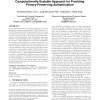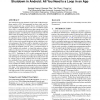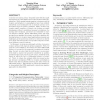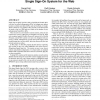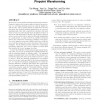CCS
2015
ACM
8 years 8 months ago
2015
ACM
Android root is the voluntary and legitimate process of gaining the highest privilege and full control over a user’s Android device. To facilitate the popular demand, a unique A...
CCS
2015
ACM
8 years 8 months ago
2015
ACM
Group signatures (GSs) is an elegant approach for providing privacy-preserving authentication. Unfortunately, modern GS schemes have limited practical value for use in large netwo...
CCS
2015
ACM
2015
ACM
From System Services Freezing to System Server Shutdown in Android: All You Need Is a Loop in an App
8 years 8 months ago
The Android OS not only dominates 78.6% of the worldwide smartphone market in 2014, but importantly has been widely used for mission critical tasks (e.g., medical devices, auto/ai...
CCS
2015
ACM
8 years 8 months ago
2015
ACM
Concerns on location privacy frequently arise with the rapid development of GPS enabled devices and location-based applications. While spatial transformation techniques such as lo...
CCS
2015
ACM
8 years 8 months ago
2015
ACM
We propose a novel dynamic software watermarking design based on Return-Oriented Programming (ROP). Our design formats watermarking code into well-crafted data arrangements that l...
CCS
2015
ACM
8 years 8 months ago
2015
ACM
Reducing attack surface is an effective preventive measure to strengthen security in large systems. However, it is challenging to apply this idea in an enterprise environment whe...
CCS
2015
ACM
8 years 8 months ago
2015
ACM
To reduce costs, organizations may outsource data storage and data processing to third-party clouds. This raises confidentiality concerns, since the outsourced data may have sens...
CCS
2015
ACM
8 years 8 months ago
2015
ACM
The ubiquity of modern smartphones means that nearly everyone has easy access to a camera at all times. In the event of a crime, the photographic evidence that these cameras leave...
CCS
2015
ACM
8 years 8 months ago
2015
ACM
Single sign-on (SSO) systems, such as OpenID and OAuth, allow web sites, so-called relying parties (RPs), to delegate user authentication to identity providers (IdPs), such as Fac...
CCS
2015
ACM
8 years 8 months ago
2015
ACM
We propose a novel wireless technique named pinpoint waveforming to achieve the location-restricted service access control, i.e., providing wireless services to users at eligible ...

